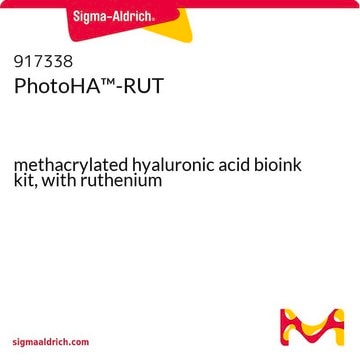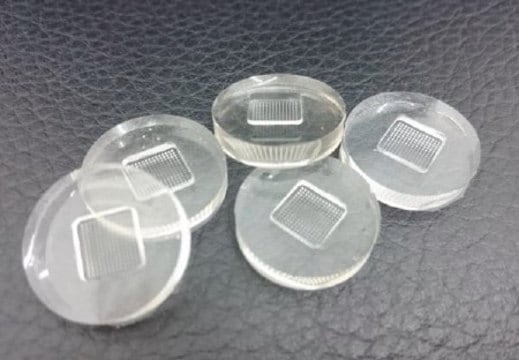The usage instructionsis as follows:
1. Calculate the desired volume of hydrogel (ECM + cells).
2. Multiply the desired volume by 0.02. This will be the amount of mL of Ruthenium and Sodium Persulfate (each) to be added to the pre-hydrogel solution.
3. Pre-solubilize the required Ruthenium in water or 1X PBS at a concentration of 37.4 mg/mL.
4. Pre-solubilize the Sodium Persulfate in water or 1X PBS at a concentration of 119 mg/mL.
5. Add the calculated volume (from step 2) of Ruthenium to the pre-hydrogel solution and mix thoroughly.
6. Add the calculated volume (from step 2) of Sodium Persulfate to the pre-hydrogel solution and mix thoroughly.
916811
Ruthenium photoinitiator kit
Scegli un formato
Scegli un formato
About This Item
Prodotti consigliati
Composizione
Ruthenium (200 mg)
Sodium persulfate photoinitiator (1 g)
Livello qualitativo
Categorie correlate
Applicazioni
Avvertenze
Danger
Indicazioni di pericolo
Consigli di prudenza
Classi di pericolo
Acute Tox. 4 Oral - Ox. Sol. 3 - Resp. Sens. 1 - Skin Irrit. 2 - Skin Sens. 1 - STOT SE 3
Organi bersaglio
Respiratory system
Codice della classe di stoccaggio
5.1B - Oxidizing hazardous materials
Scegli una delle versioni più recenti:
Possiedi già questo prodotto?
I documenti relativi ai prodotti acquistati recentemente sono disponibili nell’Archivio dei documenti.
-
What are the steps to mix together and utilize product no. 916811-1EA, the Ruthenium photoinitiator kit?
1 risposta-
Utile?
-
Filtri attivi
Il team dei nostri ricercatori vanta grande esperienza in tutte le aree della ricerca quali Life Science, scienza dei materiali, sintesi chimica, cromatografia, discipline analitiche, ecc..
Contatta l'Assistenza Tecnica.










